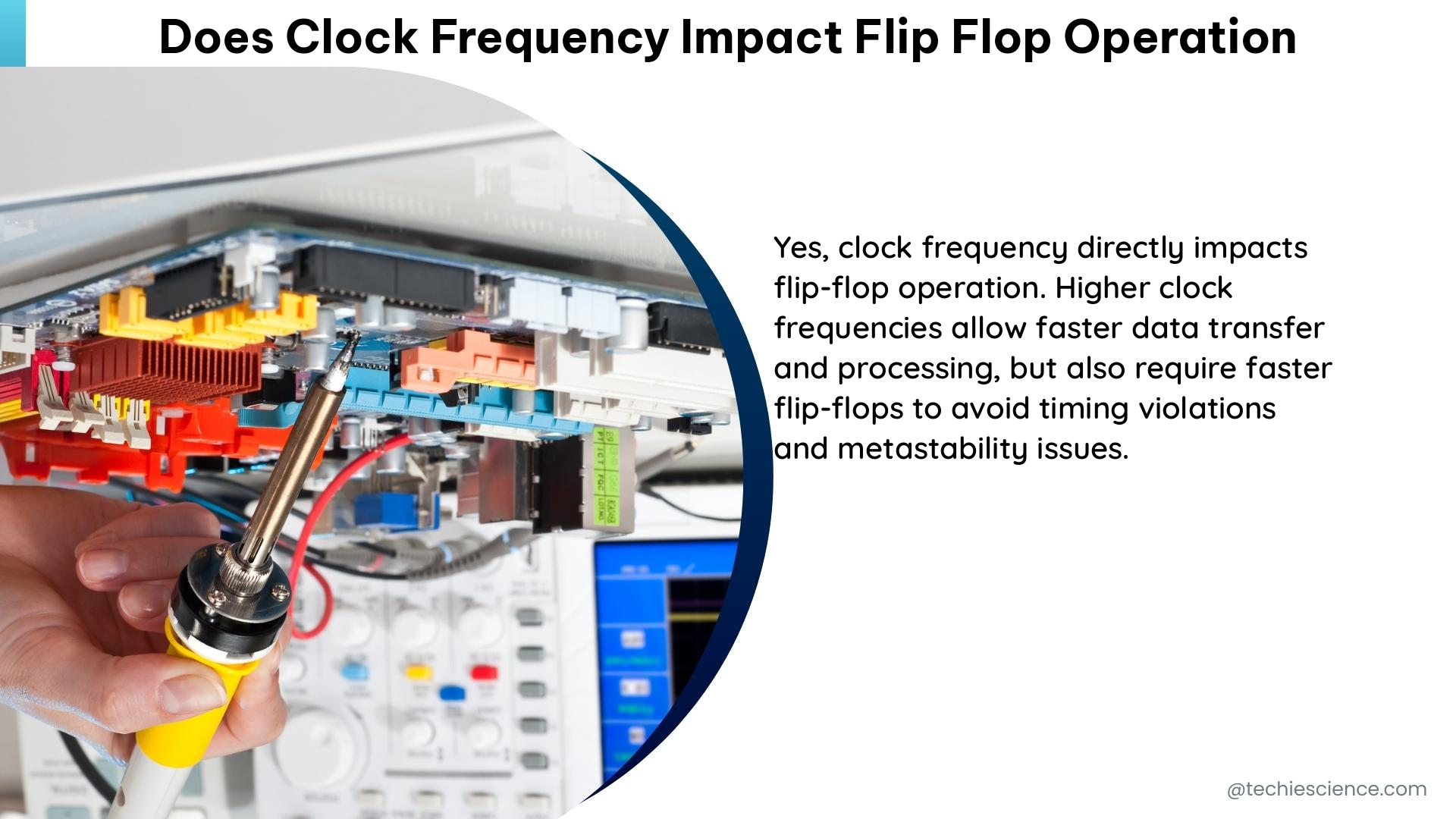The clock frequency has a significant impact on the operation of flip-flops, which are fundamental building blocks in digital circuits. Understanding the relationship between clock frequency and flip-flop behavior is crucial for designing reliable and high-performance digital systems.
Setup and Hold Times
The setup time (tsu) and hold time (th) of a flip-flop are critical parameters that determine the minimum time required for the data input to be stable before and after the active clock edge, respectively. If the data input violates either the setup or hold time, the flip-flop may enter an unpredictable state, leading to errors in the circuit’s operation.
The setup and hold times of a flip-flop are directly affected by the clock frequency. As the clock frequency increases, the setup and hold time requirements become more stringent. For example, the SN74AUC1G74 flip-flop has a typical setup time of 0.1 ns and a hold time of 0.1 ns. At a higher clock frequency, these values would need to be reduced to maintain the same level of reliability.
Clock-to-Q Contamination Delay and Propagation Delay

The clock-to-Q contamination delay (tcd) and propagation delay (tp) are also crucial parameters that determine the maximum clock frequency that can be used in a digital circuit.
The clock-to-Q contamination delay is the time it takes for the output of the flip-flop to start changing after the active clock edge. The propagation delay is the time it takes for the output to fully change after the active clock edge.
These delays are directly affected by the clock frequency. As the clock frequency increases, the clock-to-Q contamination delay and propagation delay become more critical. For the SN74AUC1G74 flip-flop, the typical clock-to-Q contamination delay is 30 ps, and the propagation delay is 80 ps.
Maximum Clock Frequency Calculation
To determine the maximum clock frequency that can be used with a flip-flop, we can use the following formula:
fmax = 1 / (2 × (tsetup + thold + tcd + tp))
Where:
– fmax is the maximum clock frequency
– tsetup is the setup time
– thold is the hold time
– tcd is the clock-to-Q contamination delay
– tp is the propagation delay
For the SN74AUC1G74 flip-flop, with a setup time of 0.1 ns, a hold time of 0.1 ns, a clock-to-Q contamination delay of 30 ps, and a propagation delay of 80 ps, the maximum clock frequency would be:
fmax = 1 / (2 × (0.1 ns + 0.1 ns + 30 ps + 80 ps))
fmax = 1 / (2 × 0.31 ns)
fmax = 1 / 0.62 ns
fmax = 1.61 GHz
Therefore, the SN74AUC1G74 flip-flop can operate at a maximum clock frequency of 1.61 GHz without degradation in its performance.
Impact of Clock Frequency on Flip-Flop Operation
The clock frequency has a significant impact on the operation of flip-flops in the following ways:
- Setup and Hold Times: As the clock frequency increases, the setup and hold time requirements become more stringent, and the risk of setup or hold time violations increases.
- Clock-to-Q Contamination Delay and Propagation Delay: Higher clock frequencies require shorter clock-to-Q contamination delays and propagation delays to maintain reliable operation.
- Maximum Clock Frequency: The maximum clock frequency that can be used with a flip-flop is determined by the setup time, hold time, clock-to-Q contamination delay, and propagation delay, as shown in the formula above.
- Timing Margin: The timing margin, which is the difference between the actual timing parameters and the required timing parameters, decreases as the clock frequency increases, making the circuit more susceptible to timing errors.
- Power Consumption: Higher clock frequencies can lead to increased power consumption in the flip-flop and the overall digital circuit, as the switching activity and dynamic power dissipation increase.
- Electromagnetic Interference (EMI): High-frequency clock signals can generate more electromagnetic interference, which can affect the performance and reliability of the digital circuit and surrounding electronics.
Considerations for Flip-Flop Design and Selection
When designing or selecting flip-flops for a digital circuit, it is essential to consider the following factors:
- Clock Frequency: Ensure that the maximum clock frequency of the flip-flop is higher than the required clock frequency of the digital circuit.
- Timing Parameters: Carefully analyze the setup time, hold time, clock-to-Q contamination delay, and propagation delay of the flip-flop to ensure that they meet the timing requirements of the digital circuit.
- Timing Margin: Incorporate a sufficient timing margin to account for variations in manufacturing, temperature, and other environmental factors.
- Power Consumption: Consider the power consumption of the flip-flop, especially if the digital circuit is designed for low-power applications.
- Electromagnetic Compatibility (EMC): Evaluate the EMC characteristics of the flip-flop, particularly if the digital circuit is operating in a noisy environment.
- Reliability: Ensure that the flip-flop has a high reliability and can withstand the operating conditions of the digital circuit, such as temperature, voltage, and stress.
By understanding the impact of clock frequency on flip-flop operation and considering these design factors, you can develop reliable and high-performance digital circuits that meet the requirements of your application.
References:
- Electronics Stack Exchange, “Confusion over clocks in FPGAs / Verilog,” 2013-11-24, https://electronics.stackexchange.com/questions/91686/confusion-over-clocks-in-fpgas-verilog
- Edaboard, “A question on flip-flops,” 2010-07-10, https://www.edaboard.com/threads/a-question-on-flip-flops.182640/
- TI Logic forum, “Minimum acceptable clock frequency to a flip flop,” 2012-04-30, https://e2e.ti.com/support/logic-group/logic/f/logic-forum/185728/minimum-acceptable-clock-frequency-to-a-flip-flop
- ScienceDirect Topics, “Maximum Clock Frequency,” https://www.sciencedirect.com/topics/computer-science/maximum-clock-frequency
- ResearchGate, “Low-Power Clock Distribution Using a Current-Pulsed Clocked Flip-Flop,” 2014, https://www.researchgate.net/publication/274263734_Low-Power_Clock_Distribution_Using_a_Current-Pulsed_Clocked_Flip-Flop

The lambdageeks.com Core SME Team is a group of experienced subject matter experts from diverse scientific and technical fields including Physics, Chemistry, Technology,Electronics & Electrical Engineering, Automotive, Mechanical Engineering. Our team collaborates to create high-quality, well-researched articles on a wide range of science and technology topics for the lambdageeks.com website.
All Our Senior SME are having more than 7 Years of experience in the respective fields . They are either Working Industry Professionals or assocaited With different Universities. Refer Our Authors Page to get to know About our Core SMEs.